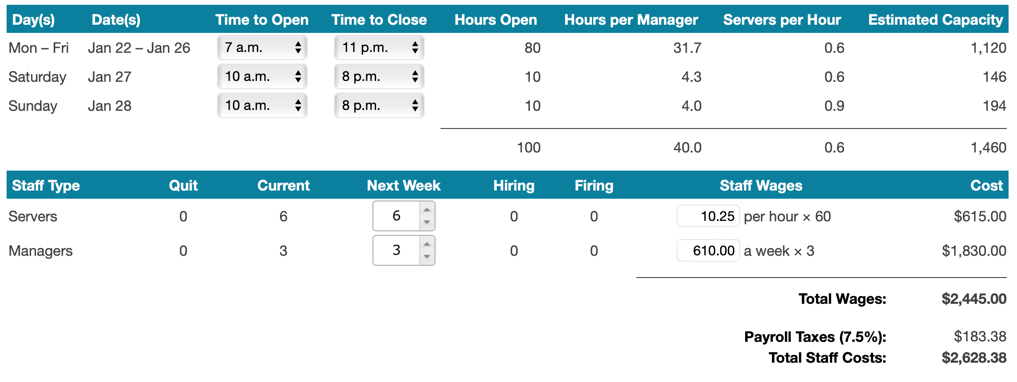Introduction
Investing in a growing business requires an in-depth analysis of industry trends and constant diligence. It is not possible to launch a successful business and direct it to spontaneous development, as this is very likely to result in a dramatic drop in operational efficiency; somewhat, constant control of variables, a focus on the market, and a trend toward innovation should drive development. This report discusses the simulation game experience based on Rose’s coffee bar’s business development.
Development Strategies
Initial Goals
Initially, Rose’s Coffee Bar was positioned as one of the most premium brands in the industry market, which was realized through an increased cost per cup of coffee. More specifically, the average cost of the coffee was 31% higher than the market average. The coffee was positioned as organic and freshly ground, which should have organically screened out only solvent consumers and brought in more profits. The interior of the coffee shop was designed in soft, calm colors, which created a comforting experience for consumers and attracted them to repeat visits, as shown in Figure 1. This strategy worked for the first time and showed an increase in profits and net income and an almost linear increase in consumer awareness of the brand.

The Complication of the Agenda
However, with the development of competition in the market and a general penchant for innovation, Rose’s Coffee Bar began to undergo significant structural distortions, leading to a worsening agenda. In particular, net profits and customer satisfaction began to fall, indicating a decline in operational efficiency (Koné Péfoyo & Wodchis, 2013). As in real life, the exact reasons for this decline were unknown, so any organizational transformations were based only on assumptions and experience. Typically, one of the critical factors in consumer dissatisfaction is the price factor — customers do not want to pay too much money for a product that differs little from competitive offerings. For this reason, one week, it was decided to introduce coffee cups in different sizes and differentiate the pricing policy. The idea was developed that now even the largest cup of coffee was to be cheaper than the previous price for the average volume — but the average cost was still slightly higher than the market average. This strategy was designed to increase the availability of premium quality among the mass consumer, which was expected to increase profits substantially.
Human Resources
As the coffee shop was rapidly ceasing to be elitist and providing more services to the mass consumer, the natural course of action was to expand its staff. Among other things, the predictor for hiring additional employees was the expansion of weekday and weekend coffeehouse hours, which will be discussed later. By the end, the number of employees at Rose’s Coffee Bar had increased to six, with the number of local managers increasing to three (Figure 2). This number was expected to maintain operational efficiency in the coffee shop and not cause turmoil due to an overabundance of employees working simultaneously. Their salaries were subject to regular indexing to keep employees and managers motivated in a rapidly changing market (Asaari et al., 2019). This reduced employee turnover and prevented employees from switching to competitors.

Figure 2 shows the actual working hours at Rose’s Coffee Bar. As can be seen, the coffee bar is open for sixteen hours on weekdays and ten hours on weekends. This expansion of working hours was done deliberately, guided by consumer behavior patterns. More specifically, on weekdays, customers are more likely to pick up coffee on their way to work or school, so the coffee shop should be open as early as possible. After work, customers can go to a coffee shop to spend their free time or do extra work remotely. The same arguments were extrapolated to weekends, but the framework was compressed by three hours on each end since this is a non-working day for most customers.
Accounting Analysis
The leading indicator of the operational effectiveness of the business is the accounting analysis, which allows indirect reasoning about the success of the implemented changes. In the first month of operation of the coffee shop, gross profit was 80% of income, and it gradually grew each week. The increase in gross profit indicates that the company is successfully making more profit than it is spending money when the cost of raw materials is unchanged (Macerick, 2021). Legitimately, as gross profit increased, there was a precipitous decrease in total costs, indicating the distribution of fixed costs with an increase in the number of assortments sold. The first three weeks saw a decrease in negative net income; although Rose’s Coffee Bar still did not reach the break-even point, the trend data signaled that it would be reached soon. The balance sheet also shows a classic downward trend in total assets, with a cumulative decline of 30.28% from the first week. The decrease in the value of assets indicates their active use in operations and shows the economic health of the business.
Key Success Factors
It is impossible to achieve objective success in simulation, as the concept is not universal and ambiguous. Success for Rose’s Coffee Bar increased the company’s net income while increasing customer satisfaction. Until these parameters were achieved, it was too early to talk about success for the coffee shop. The measures taken were aimed at achieving this success, so the situation needs to be evaluated after the data has been collected.
Findings
The critical conclusions after the simulation practice were that running a business is complicated and the need to monitor various variables constantly. In a real business, a myriad of factors must be considered; ignoring them is dangerous to operational effectiveness. It is critical to initially set achievable goals and develop strategies so that management is not intuitive.
Conclusion
To summarize, business management is a dynamic and multidisciplinary field that requires the individual to focus on the details and capabilities of a strategic vision. A real business has been simulated using the simulation in BizCafe, and it has been shown that even in the simulation, management challenges always arise. However, Rose’s Coffee Bar generally demonstrated good competitiveness and resilience to change as organizational transformations were promptly implemented to manage.
References
Asaari, M. H. A. H., Desa, N. M., & Subramaniam, L. (2019). Influence of salary, promotion, and recognition toward work motivation among government trade agency employees.International Journal of Business and Management, 14(4), 48-59. Web.
Koné Péfoyo, A. J., & Wodchis, W. P. (2013). Organizational performance impacting patient satisfaction in Ontario hospitals: a multilevel analysis.BMC Research Notes, 6(1), 1-12. Web.
Macerick, J. (2021). The difference between gross profit margin and net profit margin. Investopedia. Web.